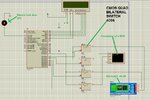emko123456789
Junior Member level 1
Hello,
I started a new project for school and i am lost, i never use PIC before.
The project is a door that can open with a RFID cart and/or with a bleutooth via a app.
For this project i will use a PIC 16F877A
Bleutooth: HC-05
RFID: Q5M-005
I2C, Bus CAN, UART, SPI, easyPIC 4
The administrator can add or remove students via Bus CAN, But all students passes will be saved on EEPROM for more reliability.
I use Proteus, isis, ares and mikroC PRO for PIC.
Thank you
I started a new project for school and i am lost, i never use PIC before.
The project is a door that can open with a RFID cart and/or with a bleutooth via a app.
For this project i will use a PIC 16F877A
Bleutooth: HC-05
RFID: Q5M-005
I2C, Bus CAN, UART, SPI, easyPIC 4
The administrator can add or remove students via Bus CAN, But all students passes will be saved on EEPROM for more reliability.
I use Proteus, isis, ares and mikroC PRO for PIC.
Thank you
